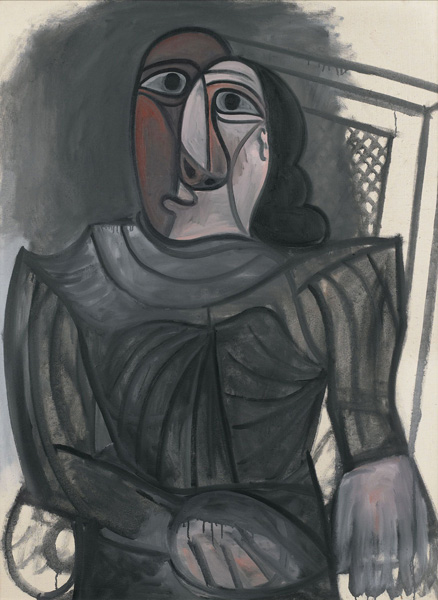However anguished Picasso may have felt about free Spain—on November 22, Franco's forces pushed the Republicans back from their initial line, marking the end of the Battle of the Ebro—he was all the more so about his future work: the empty frame stood for the death of painting. In each one of the five still lifes in the series, the palette and the brushes hold a privileged position in the center of the table and are the object of the beast's desire. However, as the artist advances in his work, the paint gradually fades from the palette. It ends up appearing totally empty in Palette and Bull's Head, so that the artist can no longer paint, a notion that is further emphasized by Picasso's decision to abandon color altogether. Here the Minotaur again becomes a bull, an ongoing presence in the artist's iconography, as it is also intrinsic to the image of Spain and bullfighting. It symbolizes both strength and impotence; the animal is a tough fighter, yet remains a sacrificial victim. Turning the genre of the academic still life inside out, Palette and Bull's Head is an astounding allegory of free Spain, both combative and powerless, but also of the artist's struggle for creative freedom. Although Picasso initially refused to admit to this series being interpreted as a condemnation of fascist oppression, he stated in an interview with Pol Gaillard published in New Masses in 1944: "I never considered painting an art of mere enjoyment, of distraction. Through design and color, since those are my weapons, I have tried to penetrate deeper into knowledge of the world and of men so that this knowledge would free us more each day. In my own way I have always said what I considered most true, most just and best, and, therefore, most beautiful. The greatest of artists know this well.”
"Picasso's portraits and figures are of cardinal importance. They are his most vital paintings of the war years. Distorted, grotesque, anguished, convulsed, pensive, or gay, they offend, sting, challenge, or shock the observer. The creative artist necessarily being in advance of his audience, his work is often baffling at first sight." Those are the terms in which American collector Sidney Janis opened his chapter about the seated women portrayed by Picasso during the war years in his Picasso: The Recent Years, 1939-1946, published in 1946. Seated Woman in a Grey Dress, painted during the summer of 1943 in his studio on the rue des Grands-Augustins, when Paris was under the Vichy regime, is an outstanding example. Stepping back from the traditional canons of female beauty, it conveys undeniable power.





 Summary
Summary